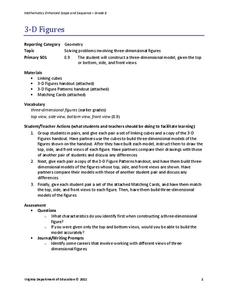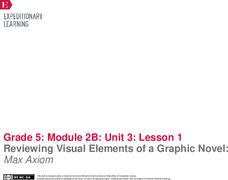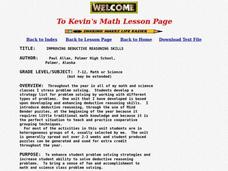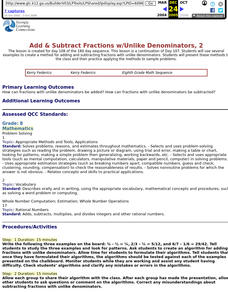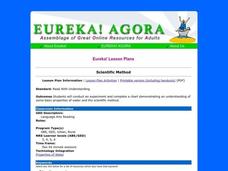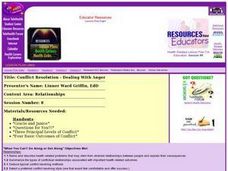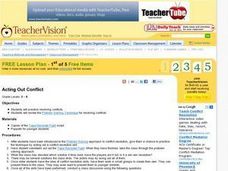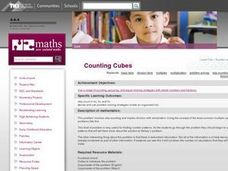Virginia Department of Education
Distance and Midpoint Formulas
Small groups work through two guided activities to derive the distance and midpoint formulas for the coordinate plane. The activities begin with concrete examples and move to abstract.
Serendip
Golden Rice – Evaluating the Pros and Cons
More than half the world's population eats rice as a daily staple ... imagine if that rice could prevent illness. Scientists genetically engineered rice to include vitamin A for just that purpose. However, room for debate still exists....
Virginia Department of Education
3-D Figures
Scholars construct three-dimensional figures to study dimension and side views. Learners build models using linking cubes to match views of different sides. After practicing with models, they attempt to match three-dimensional drawings...
Virginia Department of Education
Lines and Angles
Explore angle relationships associated with transversals. Pupils construct parallel lines with a transversal and find the measures of the angles formed. They figure out how the different angles are related before constructing...
Missouri Department of Elementary
Character Clovers
Build a classroom community with a lesson that uses character clovers to examine scholars' roles. Following a whole-class discussion, participants list four roles they play and accompany it with the character traits that go along with it.
EngageNY
Reviewing Visual Elements of a Graphic Novel: Max Axiom
Pass the tea! Using the resource, scholars participate in a Tea Party protocol to analyze text and images about inventions that helped meet societal demands. After sharing their observations with each other, they discuss visual elements...
Curated OER
The Design Process
Students work together to construct a foundation of nine 3" x 5" index cards to support their 9" textbook off their desk. They summarize the steps used to solve the problem and discuss and compare their solutions. They then complete the...
Curated OER
Improving Deductive Reasoning Skills
Students recognize problems that may be solved using deductive reasoning, and develop aids to help them in solving these problems. They produce their own deductive reasoning puzzles for other students to solve.
Curated OER
Jack and the Beanstalk Estimation
Students use estimation and pencil-paper calculations to help Jack and his mother solve a variety of life problems. They solve problems using various math operations, i.e., addition, subtraction, and measurement.
Curated OER
Add & Subtract Fractions w/Unlike Denominators, 2
Students use several examples to create a method for adding and subtracting fractions with unlike denominators. They present these methods to the class and then practice applying methods to sample problems.
Curated OER
Pirate Swords
Students read the math problem and retell it in their own words. They brainstorm for ways to solve and use questions to focus on the steps used. Students could use other problems involving pirates from the given website.
Curated OER
More Pizzas and Things
Students are introduced to the problem by playing a guessing game of "I am a number, which is half of 6 and 6, what am I?" They explain their answers and see if anyone else had an alternate solution checking for reasonableness.
Curated OER
Scientific Method
High schoolers explore the steps in the scientific methods. Through activities, students discover the scientific is a tool for solving problems of any kind. High schoolers will fill out a scientific method chart, and determine what...
Curated OER
Conflict Resolution - Dealing With Anger
Students summarize the types of conflictual relationships associated with important health related outcomes. They deduce typical conflict resolving methods. They select a preferred conflict resolving style. They role-play a situation and...
Curated OER
Math Games
Fourth graders participate in a lesson that is involved in the breaking of codes using computer games. They access the internet to play math games. The teacher uses powerpoint to help guide students with common problems in loading and...
Curated OER
Acting Out Conflict
Students practice solving given conflicts. They act out different scenerios and decide on the best one. They discuss questions to end the activity.
Curated OER
Education: Activities for Multiple Intelligences
Students explore the various types of intelligences and develop strategies to include them in their classrooms. In groups, they research multiple intelligences and create posters about them. Students present their posters to the class...
Curated OER
Design a Better Classroom Workplace
Students design a new classroom workplace. For this architecture lesson, students use area formulas to identify the problem with the existing desks in their classroom. Students design their own solution volume formulas to solve the...
Curated OER
The Circle's Measure
Students explore circumference and diameter. For this math lesson, students apply their knowledge of circumference and diameter to solve mathematical riddles. Students apply this knowledge to find circumference and diameter of various...
Curated OER
Get the Turtle to the Pond
Young scholars solve problems. In this math activity, students write solutions using LOGO commands in order to help get the turtle to the pond.
Curated OER
Counting Cubes
Students count backwards in 2s from 30 then try other skip patterns such as 1,3,5, etc. and invent their own counting patterns. They are introduced to the problem using a pile of cubes and count by 2s and have a remainder.
Curated OER
More of Carrie's Cubes
Students solve a word problem that explores the shape of a cube and ways that part of it can be colored. They discuss the problem and analyze a Rubik's cube, explore the problem using a graph, and discuss the solutions as a class.
Curated OER
Taking Action Against Child Labour
Students identify and clarify a problem, issue or inquiry, locate and record information from a variety of sources and identify alternative interpretations from specific historical and contemporary sources. They asses at least two...
Curated OER
Two By One Multiplication
Third graders use base-ten blocks to find products of two-digits by one-digit by making a model of the problem. They complete a worksheet by multiplying 2-digits by 1-digit with regrouping. They may use the base-ten blocks if needed.
Other popular searches
- Problem Solving Strategies
- Problem Solving Strategies
- Problems Solving Strategies
- Ten Problem Solving Strategies




